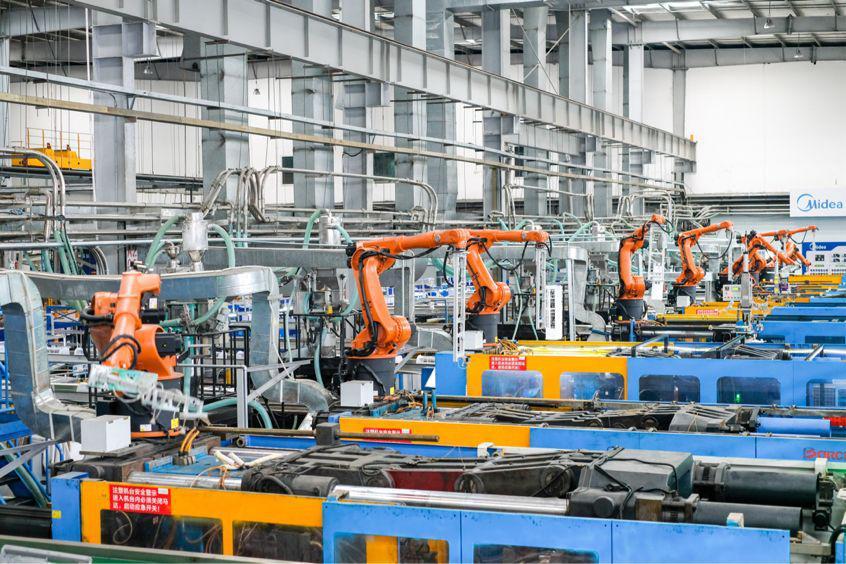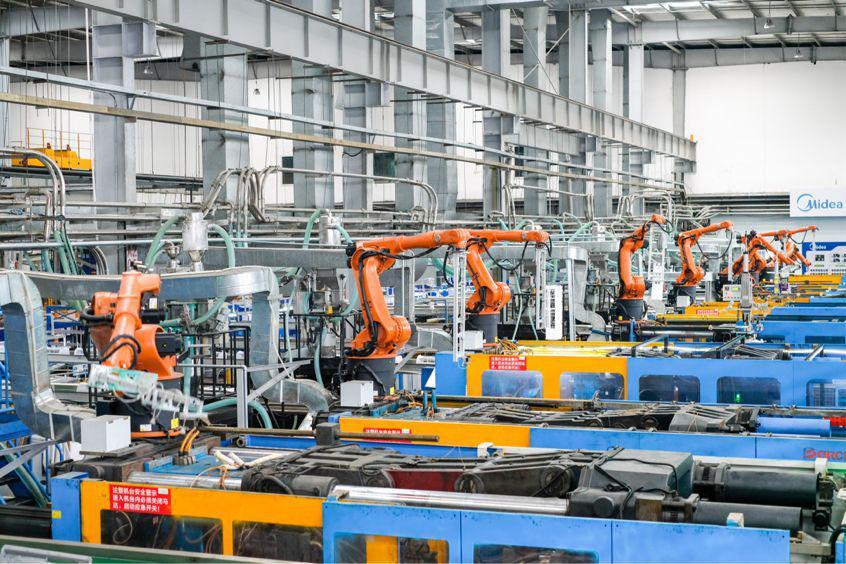
{{ lang?'快速选择':'Quick select' }}:
概念:
数字化和自动化是两个不同的概念,尽管它们是可以相互关联。
数字化通常是指将模拟数据转换为数字数据的过程,这涉及到使用计算机系统、软件和信息技术来实现。数字化可以应用于各种领域,包括医疗、金融、制造业等,它能够使信息更容易地被处理、存储和传输。
自动化则是指在生产、制造或管理过程中,通过机器、设备或系统自主地完成某些任务或流程,而不需要人工直接干预的过程。自动化可以显著提高生产效率、降低成本、减少人为错误,并提高工作质量。
虽然数字化和自动化在某些方面可以相互关联,但它们并不是同一个概念。数字化可以为自动化提供更高效、精确的数据处理和分析能力,而自动化则可以使生产过程更加高效、灵活和可靠。
数字化工厂与自动化工厂的区别:
数字化工厂与自动化工厂,到底有何区别?要追赶未来制造,人与机器之间关系如何重构?为什么反复强调,提升质量而非降低成本,才是工业进化的本质?要真正迈向工业4.0,将继续往哪些方向进行摸索?
如果说,对工厂架构和组成的实地走读,给我们带来的是实践层面的冲击。那么,对工厂运转理念和管理模式的前沿解读,相信将可以给我们带来思维层面的更多启示,乃至启蒙。
“数字化工厂”不等于“自动化工厂”
数字化制造中,尽管自动化制造是重要的基础,但数字化制造并不等同于自动化。一般情况下,很多人会以为工厂要实现数字化制造,必须先实现自动化,这其实是一种误解。
伴随人口红利逐步消失,一场“机器换人”的自动化革命正在如火如荼地进行。这场变革不仅带动本地机器人产业发展,也引来国际机器人企业到来。通过“自动化制造”,破解劳动力成本上涨、劳动力结构性短缺的问题,是最迫切的需求。
数字化制造的其中一个重要基础,正是实现自动化制造。
在某企业的自动物流系统部门,两部高速运转的取料机如同“人”一样,依靠数字定位迅速地“抽”出对应的原材料,并通过自动传输轴,马上传送到生产车间。从工厂物料需求信息传导到自动物流仓库,仓库最长只需要30分钟就能将物料送到了车间,中间无需任何人员操作。在这座实现了全集成自动化的工厂内,相比同类型的工厂人员最多可节省50%。那么,伴随生产车间内不断增加自动化设备,以及逐步减少劳动力,在数字化制造的不断进化中,是否就等同于全自动化?
要明确的是,数字化制造并不等于全自动化制造。一般情况下,很多人会以为工厂要实现数字化制造,必须先实现全自动化,这其实是一种误解。
以电子行业为例,如果开发一条全自动化的产线,至少需要半年以上,但按照目前电子行业的创新周期,一般情冴下,一款电子产品从设计到实现量产普遍只在几个月内。这时候,生产线上大部分的工作只有依靠人来完成,速度才会更快。当行业的生产线更新周期太快,投入了很高的自动化成本,但生产效率幵没有得到明显的提升。所以,全球大多数的电子产品制造方案几乎都不会用自动化生产线来完成,而组装环节也很少采用机械臂。

工业进化本质在提升质量,而非降低成本
人力成本被认为是导致近年制造业竞争力下降的原因,但制造业不能仅仅盯着制造环节的成本,应该更加注重供应链成本。而数字化制造从一开始就不仅仅是为了降低成本,最大的目的在于提升质量,而高质量并不意味高成本。
以一个简单的例子来看,当一款产品出厂时,它同时拥有了两个价值,一个是出厂价值,一个是到客户手中时的价值。中国很多工厂生产出来的产品,出厂价值不高,但到客户手中的价值就很高,这就是供应链的问题。
尽管并不需要仅仅盯着成本来谈论“工业进化”,但数字化制造本身所带来的高质量并不代表是高成本。高质量在工业制造领域的重要性不言而喻。作为耐用品的工业产品,比如一款海上风力发电机的产品,一旦出现问题,不仅造成的损失不可估量,而且需要动用到直升机维修,维修的后期成本也非常高。
为此,在实现质量提升上,数字化制造首先是借助自动化产线上的机器充当“纠错官”的角色,比如当工人少拧了一颗螺丝,机器会自动发出警示,阻止产品进入下一个环节,通过机器的协助,减少人的出错。通过机器的“检查”杜绝人在制造过程的差错,这只是保证产品质量的基础一步,由制造质量、研发质量以及原材料质量组成的产品质量中,更需要的是借助数字化制造去保障研发质量和原材料质量。尤其是如何保证原材料质量,一直被认为是制造业界最具挑战性的一个课题。
在数字化制造过程中,一个很重要的方式是对原材料进行可溯源式的管理。也就说,在这座工厂内,当来自各地的原材料被运送到车间后,所有的原材料都拥有了自己的“身份证”。这个身份证可伴随原材料进入生产线,在每一个流程中,都会被相应的设备进行数据的采集和跟踪,幵最终储存在后台的数据管理中。这意味着,一旦有原材料的质量出现问题,工厂可以马上查找到这一批次的原材料在什么时间点,已经走过哪些生产流程。无论客户在今后什么时间反馈质量问题,工厂依旧能够拿出完整的数据,对这些原材料进行追溯,从而保证原材料的质量。
走向工业4.0,管理自动化才是关键
在数字化制造的阶段,通过数据交互,已经能够有效地提升管理效率。但要衡量是否真正走向工业4.0,不是看生产线自动化水平的高低,而是看管理水平的高低。实现管理的自动化,需要实现管理上人完全听命于“电脑”,这才是智能制造的未来。
在工业4.0的研究中,智能制造和智能工厂一直被认定为两大研究主题。其中,关于智能工厂,被描绘成是一个分散的、具备一定智能化的生产设备,在实现了数据交互之后,形成了高度智能化的有机体,实现虚拟世界和物理世界的融合。
数字化工厂与智能化工厂之间的差距,最关键的一点在于是否真正实现管理的自动化。
在中国制造实现智能化提升的路上,相比硬件设备,管理水平的高低才是影响中国企业能否实现工业4.0的关键。要真正实现工业4.0,一大标准是管理水平达到了一定的高度,甚至实现了自动化。工业4.0将工业软件提升到了前所未有的高度。工业4.0将各种工业软件充斥到制造流程之中,从供应链管理、产品设计、生产管理、企业管理等四个维度,提升“物理世界”中的工厂/车间的生产效率,优化生产工程。工业4.0中囊括了MES(制造执行管理系统)、DNC(数控机床及生产工位联网管理系统)、MDC(数控机床状态及生产数据采集分析管理系统)、PDM(制造过程生产数据文档管理系统)、Tracker(工装及刀夹量具智能管理系统)、SCM(产业链管理)、PLM(产品生命周期管理)、CAD(计算机辅助设计)等软件系统,能够将分散的各种信息汇总分析,从而解决产品生命周期的丌断缩短、物流交货周期的丌断加快以及客户定制要求的多样化的问题,为制造工艺带来决定性的影响。
如果管理实现自动化,也可以理解为,工厂的所有决策和指令都听命于电脑,连人也是听命于电脑。实现这一步并不容易,至少从理念上,如何让人完全听命于电脑,则需要一场思维变革。
但至少,数字工厂作为实现智能工厂的必经之路,已走出了第一步——让机器代替人去做更多的决策。而等到工厂内,真正能用自动化替代人进行管理,人听命于“电脑”的话,那么,电脑背后所代表的制造的未来,也将来到眼前。
Concept:
Digitalization and automation are two different concepts, although they can be interrelated.
Digitization usually refers to the process of converting analog data into digital data, which involves the use of computer systems, software, and information technology to achieve. Digitization can be applied to various fields, including healthcare, finance, manufacturing, etc. It can make information easier to process, store, and transmit.
Automation refers to the process of autonomously completing certain tasks or processes through machines, equipment, or systems in production, manufacturing, or management processes without the need for direct human intervention. Automation can significantly improve production efficiency, reduce costs, reduce human errors, and improve work quality.
Although digitalization and automation can be interrelated in some aspects, they are not the same concept. Digitization can provide automation with more efficient and precise data processing and analysis capabilities, while automation can make production processes more efficient, flexible, and reliable.
The difference between digital factories and automated factories:
What is the difference between a digital factory and an automated factory? How to reconstruct the relationship between humans and machines in order to catch up with future manufacturing? Why repeatedly emphasize that improving quality rather than reducing costs is the essence of industrial evolution? To truly move towards Industry 4.0, which directions will we continue to explore?
If we talk about on-site visits to the factory architecture and composition, it will bring us a practical impact. So, a cutting-edge interpretation of factory operation concepts and management models is believed to bring us more insights and even enlightenment in terms of thinking.
"Digital factory" does not equal "automated factory"
In digital manufacturing, although automated manufacturing is an important foundation, digital manufacturing is not equivalent to automation. In general, many people may think that in order for factories to achieve digital manufacturing, automation must be achieved first, but this is actually a misunderstanding.
With the gradual disappearance of the demographic dividend, an automated revolution of "machine replacement" is underway in full swing. This transformation not only drives the development of the local robotics industry, but also attracts international robotics companies. The most urgent need is to solve the problems of rising labor costs and structural labor shortages through "automated manufacturing".
One of the important foundations of digital manufacturing is to achieve automated manufacturing.
In the automatic logistics system department of a certain enterprise, two high-speed operating reclaimers act like "people", relying on digital positioning to quickly "extract" corresponding raw materials, and immediately transmit them to the production workshop through an automatic transmission shaft. From the factory's material demand information to the automated logistics warehouse, it only takes up to 30 minutes for the warehouse to deliver the materials to the workshop, without the need for any personnel to operate in the middle. In this factory that has achieved fully integrated automation, personnel can be saved up to 50% compared to similar factories. So, with the continuous increase of automation equipment in the production workshop and the gradual reduction of labor force, is it equivalent to full automation in the continuous evolution of digital manufacturing?
It should be clarified that digital manufacturing does not equate to fully automated manufacturing. In general, many people think that in order for factories to achieve digital manufacturing, they must first achieve full automation, which is actually a misunderstanding.

Taking the electronics industry as an example, if a fully automated production line is developed, it will take at least six months. However, according to the current innovation cycle of the electronics industry, in general, the design to mass production of an electronic product is only a few months. At this point, most of the work on the production line can only be completed faster by humans. When the production line update cycle in the industry is too fast, high automation costs are invested, but production efficiency has not been significantly improved. So, most electronic product manufacturing solutions around the world are almost never completed using automated production lines, and robotic arms are rarely used in the assembly process.
The essence of industrial evolution is to improve quality rather than reduce costs
The cost of labor is considered to be the reason for the decline in competitiveness of the manufacturing industry in recent years, but the manufacturing industry should not only focus on the cost of the manufacturing process, but should pay more attention to supply chain costs. From the beginning, digital manufacturing was not only aimed at reducing costs, but also at improving quality, and high quality does not necessarily mean high costs.
Taking a simple example, when a product leaves the factory, it has two values at the same time, one is the factory value and the other is the value when it reaches the customer's hands. Many factories in China produce products with low factory value, but the value in the hands of customers is high, which is a problem with the supply chain.
Although it is not necessary to solely focus on cost to discuss industrial evolution, the high quality brought by digital manufacturing itself does not necessarily mean high costs. The importance of high quality in the field of industrial manufacturing is self-evident. As a durable industrial product, such as an offshore wind turbine, if there is a problem, it not only causes incalculable losses, but also requires the use of helicopters for maintenance, and the later cost of maintenance is also very high.
Therefore, in achieving quality improvement, digital manufacturing first relies on machines on automated production lines to play the role of "error correction officers". For example, when a worker misses a screw, the machine will automatically issue a warning to prevent the product from entering the next stage. With the assistance of the machine, human errors are reduced. Eliminating human errors in the manufacturing process through machine inspection is only a fundamental step in ensuring product quality. In the product quality composed of manufacturing quality, research and development quality, and raw material quality, it is more necessary to use digital manufacturing to ensure research and development quality and raw material quality. Especially how to ensure the quality of raw materials has always been considered the most challenging issue in the manufacturing industry.
In the process of digital manufacturing, an important way is to manage raw materials in a traceable manner. That is to say, in this factory, when raw materials from various places are transported to the workshop, all raw materials have their own "ID cards". This ID card can accompany raw materials into the production line, and in each process, it will be collected and tracked by corresponding equipment for data collection, and ultimately stored in the backend data management. This means that once there is a quality issue with the raw materials, the factory can immediately find out at what time and which production processes this batch of raw materials has gone through. No matter when customers provide feedback on quality issues in the future, the factory can still provide complete data and trace these raw materials to ensure their quality.
Moving towards Industry 4.0, Management Automation is the Key
In the stage of digital manufacturing, data exchange has effectively improved management efficiency. But to measure whether we truly move towards Industry 4.0, it's not about the level of production line automation, but about the level of management. To achieve automation in management, it is necessary to fully obey the "computer" in management, which is the future of intelligent manufacturing.
In the research of Industry 4.0, intelligent manufacturing and intelligent factories have always been recognized as two major research topics. Among them, the intelligent factory is depicted as a decentralized and intelligent production equipment, which, after achieving data exchange, forms a highly intelligent organism, achieving the integration of the virtual world and the physical world.
The most crucial difference between digital factories and intelligent factories lies in whether management automation is truly achieved.
On the road to achieving intelligent improvement in manufacturing in China, the level of management is the key to whether Chinese enterprises can achieve Industry 4.0 compared to hardware equipment. To truly achieve Industry 4.0, a major standard is that the management level has reached a certain level, and even automation has been achieved. Industry 4.0 has elevated industrial software to unprecedented heights. Industry 4.0 incorporates various industrial software into manufacturing processes, enhancing the production efficiency of factories/workshops in the "physical world" and optimizing production engineering from four dimensions: supply chain management, product design, production management, and enterprise management. Industry 4.0 includes software systems such as MES (Manufacturing Execution Management System), DNC (CNC Machine Tool and Production Station Networking Management System), MDC (CNC Machine Tool Status and Production Data Collection and Analysis Management System), PDM (Manufacturing Process Production Data Document Management System), Tracker (Intelligent Management System for Fixtures and Tool Clamps), SCM (Industry Chain Management), PLM (Product Lifecycle Management), CAD (Computer Aided Design), etc, Being able to aggregate and analyze various scattered information, thereby solving the problems of shortened product lifecycle, accelerated logistics delivery cycle, and diversified customer customization requirements, bringing decisive impact to manufacturing processes.
If management is automated, it can also be understood that all decisions and instructions in the factory are under the command of the computer, and even people are under the command of the computer. It is not easy to achieve this step, at least conceptually, how to make people fully obedient to computers requires a change in thinking.
But at least, as a necessary path to achieving intelligent factories, digital factories have taken the first step - allowing machines to replace humans in making more decisions. And when automation can truly replace human management in the factory, and humans obey the orders of "computers," then the future of manufacturing represented by computers will also come before our eyes.






